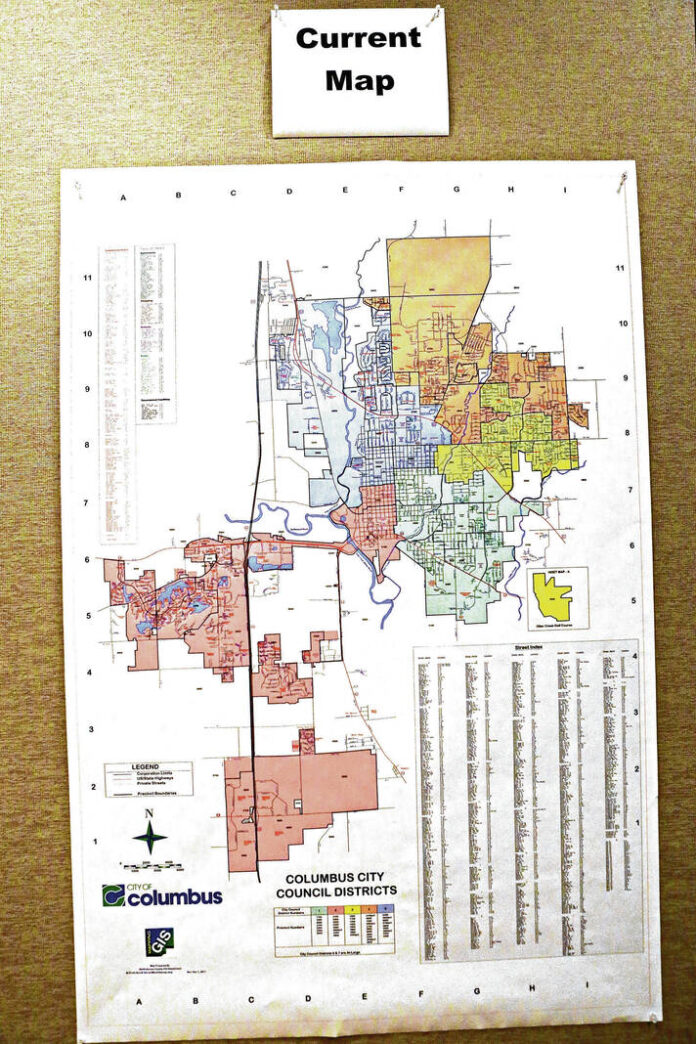
Carla Clark | For The Republic The current city council district map during the redistricting meeting held at Columbus City Hall in Columbus, Indiana, Monday, September 12, 2022.
Proposed maps for Columbus City Council redistricting have been shared with the public, although it will be a few weeks before council members vote on the proposal and a little more than a year before the changes — including the creation of a new, sixth district — officially go into effect.
City officials held an open house on Monday to present proposed district maps for Columbus City Council, answer questions and get feedback from residents. About 15 people attended over the course of the two-hour session, with most indicating they approved of the proposal.
The plan is for the district maps to be on the council’s Sept. 20 meeting as a discussion item, said city officials. The council would then have its first vote on the maps on Oct. 4, followed by a second vote on Oct. 18. Community members are welcome to contact council members with their feedback and are also able to comment at council meetings.
City council district changes, once approved, would go into effect starting in 2024.
All cities are required to review council district boundaries this year in consideration of the 2020 census. Additionally, the creation of a new, sixth district, is included in this proposal, since the council recently voted to adopt “second class” status for the city of Columbus, which will also go into effect in 2024. The transition entails a number of changes to city structure. One of the most notable is the addition of two new city council members.
Indiana’s second class cities each have a legislative body made up of nine members — six members representing six districts and three at-large members. Columbus City Council is now made up of five district representatives and two at-large.
On the proposed map, District 6 would be located in central and north Columbus, with most of its area coming from the current District 4, as well as a small portion of District 3.
Additionally, District 4 would gain some pieces of District 3. Some areas of District 5 and District 1 would now be located in District 3. District 1 would include some areas that are currently part of District 2, including downtown Columbus and a stretch of Jonathan Moore Pike from the East Fork White River to Little Creek Shopping.
Councilman Frank Miller (R-District 4) said that if the maps are approved, District 1 Councilman Jerone Wood (D) would have to file to run for District 3 based on his current residence.
Chris Rutan (R), who said he plans to run for city council in 2023, faces a similar prospect. He feels that the changes would make for a more balanced district, in terms of different incomes and perspectives.
Areas such as Greenbelt Golf Course, Garland Brook Cemetery and Clifty Creek Elementary would be added to District 3, assuming the new map is approved.
The redistricting proposal was a bipartisan effort. Miller and Councilman-at-large Tom Dell (D) worked on the project together, with other city and county officials also contributing to the work.
“We think it’s a fair proposal,” said Dell. He said that they tried to make districts as contiguous as possible so that people will feel that their district representatives are part of their communities. They also worked to put precincts back together rather than having them split up.
Bartholomew County Democratic Chairman Steve Schoettmer, who lives in the county, expressed appreciation for the proposal and the efforts to unite precincts.
“It shows a desire to do it fair,” he said. “I like that.”
Democrat Cinde Wirth, who is running against Rep. Greg Pence for Indiana’s Sixth Congressional District, likewise commended the plans. Under the proposal, she would switch from District 2 to District 1.
Another consideration is that state law requires that each district’s population should be within 10% of the number that represents the city’s population divided by its number of districts, said Dell. According to data provided by Miller, the recent census puts Columbus’s population at 50,224, which puts the district average at 10,045 when there are five districts and 8,371 when there are six.
For both the current and the proposed map, District 2 (represented by Councilwoman Elaine Hilber, D) remains a large outlier. Its current population is 12,337. If changes are approved, that would drop to 9,135, which is still 9.1% more than the new district average.
“Those are such huge precincts out on the west side,” said Miller. “Because when they were formed, they were rural or not part of the city yet. So they were larger. But now the population of those large precincts has exploded. … But 10 years from now, that’s going to be a totally different situation. … Something’s going to have to change there, because 2’s going to continue to grow.”
Stephanie Carmer, who currently lives in District 4 and would be in District 6 under the proposal, said she’s glad for the addition of new council members and generally happy with the new maps.
“They look fairly split up, like there’s a good mix of neighborhoods in each district,” she said. “And we’re growing. We need more people to represent the fact that we have more people. I think it’s time.”
However, she also said that there are a couple of things that look odd with District 1 and 3, and it’s hard to say how housing changes and new growth will change the city over time.
“I guess I’ve got to trust the process,” she said.
Jay Foyst, who would also move from District 4 to District 6, feels that the addition of a new district is a positive indicator for Columbus’ growth. Having been born in Columbus and lived here for most of his life, he can remember when the population was under 30,000.
“It’s good to see Columbus do so well,” he said. “We’ve attracted a lot of people over the years.”




